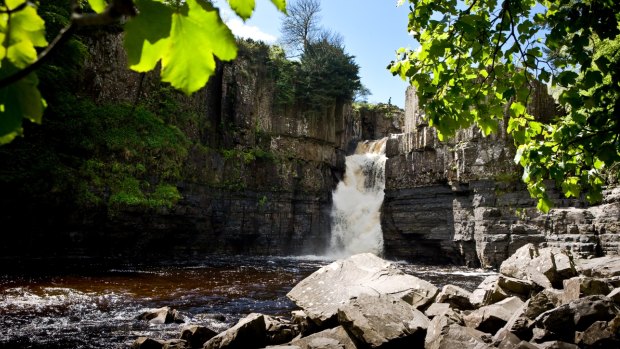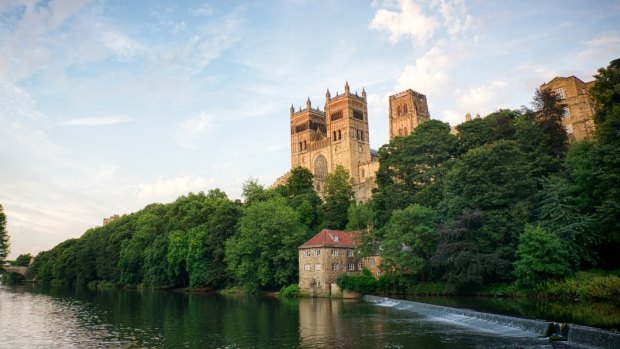This was published 5 years ago
Durham, England: So magical, it inspired the epic modern tale of Harry Potter
By Sue Williams

High Force Waterfall, Durham Dales.Credit: VisitEngland/Visit County Durham
Murder, mayhem and miners – they're the three elements that have most defined the history of one of Britain's most beautiful cities.
As the northernmost site of William the Conqueror's push to quash rebellious locals after 1066 and all that, the ancient city of Durham, just south of Newcastle, was a place of more bloodshed than any of the kingdoms of Game of Thrones.
"Forget about Jon Snow," says history PhD student Chris, who moonlights as a guide to Durham's stunning 11th century Norman castle. "We had William Walcher who was the real king of the north."

Durham's awe-inspiring Norman cathedral looms large above the River Wear.Credit: VisitEngland/Diana Jarvis
His claim to the title was iron-fisted, too. As the priest appointed the Bishop of Durham in 1071 by William the Conqueror, he was granted huge powers and used them with abandon against his foes.
After his henchmen slaughtered his greatest critic in a middle-of-the-night raid, he led a party of 100 for peace talks with the family's survivors. When he rejected their terms, however, he was forced to take refuge in a nearby church that his enemies set ablaze, and then cut him down as he fled from the flames. It's a history as riveting as anything George R.R. Martin could ever write.
These days, of course, Durham is a beautiful – and extremely peaceful – place of immense natural and heritage beauty, but the story-telling is no less compelling. Opposite the castle across the emerald expanse of Palace Green, in rather more recent times, Durham's awe-inspiring Norman cathedral doubled as a film location for a modern epic tale: as the Hogwarts School of Witchcraft and Wizardry for Harry Potter.
It's little wonder that this UNESCO World Heritage site has become a backdrop to such real, and imagined, histories.
The tranquil River Wear winds around the city and, fringed with natural woodland, blossoms, wild garlic and quiet gravel paths along either side, it offers spectacular views of the castle and cathedral towering 30 metres above.
Rowers slip silently past under the several stone bridges crossing the river, with the oldest dating back to 1170, and are interrupted only by a series of weirs as they approach the main city.
That city centre also reeks of history, with an ancient marketplace, medieval walls, a Norman archway, cobblestone paths up and down alleyways and buildings dating from the English Civil War and Cromwellian period. Many of the historic buildings have these days been taken over by Durham University, founded in 1832 as one of Britain's oldest universities. Students live, for instance, behind 1.2-metre thick walls in the castle in one of the earliest residential colleges that gives the space a new lease on life and a sense of living history.
Yet, that's not to say the fighting stopped in Durham with the end of the English Civil War in the 17th century. In the 1970s, there was well-publicised friction between students and locals and there were a few running battles in the city centre between the so-called "gownies" and "townies". Now, with about 18,000 students in Durham, there are too many reinforcements to risk it.
Coal, a decade later, provided another flashpoint for discord. It had been mined in the area since medieval times and the Industrial Revolution meant there was hardly a local village without a colliery. But the 1980s saw pitched battles between striking miners and the police after British prime minister Margaret Thatcher tried to close down the coal industry that had kept most of those villages going.
Many now have magnificent memorials to mark their heritage, while 150,000 people march in the Miners' Gala on the streets of Durham every July. One of the city's most beautiful buildings is its historic Miners' Hall in Redhills, with its heritage banners and grand council chamber, known as the Pitman's Parliament.
"You can almost feel the pride as you walk in here," says Arnie Freeman, a regular visitor. "The hair still stands up on the back of my neck every time I come."
Throughout Durham there are now also some wonderful restaurants, cafes and bars – including what's lauded as the smallest gin bar in the world, The Tin of Sardines, with 200 brands of gin and room for only 16 people.
There's afternoon cream teas served in the cathedral's undercroft, and a heady selection of pubs, from modern gastropubs to the traditional types that serve a regular clientele with Sunday roasts.
"Hello there! Don't I know you?" a barmaid from one of the latter calls across to my travel companion, who had last visited 16 years before.
A keen respect for history is never far away.
TRIP NOTES
Sue Williams travelled at her own expense.
MORE
GETTING THERE
Trains run north from London's Kings Cross station (about 2 hours, 38 minutes) and south from Edinburgh (about 1 hour, 37 minutes).
STAY
There's a huge selection of hotels, pubs, B&Bs and apartments to let. Out of term, you can stay in the castle or at any of the university colleges.
EAT
The cosy Italian Gussto is hidden down a historic alleyway at 32 Silver Street. See facebook.com/GusstoDurham
Sign up for the Traveller Deals newsletter
Get exclusive travel deals delivered straight to your inbox. Sign up now.